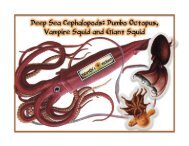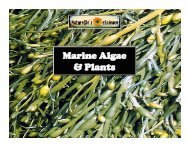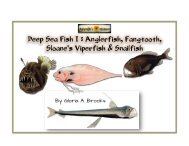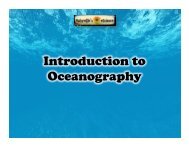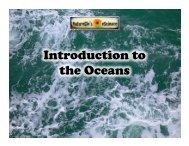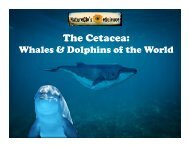Lesson #8 - Deep-sea Cnidarians POWERPOINT
You also want an ePaper? Increase the reach of your titles
YUMPU automatically turns print PDFs into web optimized ePapers that Google loves.
Dramatic
Deep-sea
Creatures:
Animated
PowerPoint
Giant Jellyfish, Venus Flytrap Sea Anemone,
Orange Sea Pen & Bubblegum Coral
NatureGlo's eScience Copyright 2016
Revised 5/15/20
Permission is granted to reproduce this PowerPoint per student in a one family household, per
student and teacher in a single teacher’s classroom and for the purchaser’s personal use only.
Cover – Left to right: Stygiomedusa gigantea, Venus’ Fly Trap Anemone, Bubblegum coral and
(bottom left) Orange sea pen. All images credit: NOAA.
Contact – Gloria Brooks natureglosescience@gmail.com
Image credit: freebie.photography / stockarch.com
The Giant Jellyfish Stygiomedusa gigantea
• Giant deep-sea
jellyfish in family
Ulmaridae
• Only 115 sightings in
last 110 years; rarely
seen
• One of largest
deep-sea
predatory
invertebrates
• Color - umbrella & oral
arms: pinkish-purple
• Geographic range – believed
worldwide; observed and filmed
off Pacific coast of United States
by scientists and by ROVs off
Japan coast and Gulf of Mexico
Image credit: MBARI/NOAA
The Giant Jellyfish –
Physical Description
• Umbrella-shaped
bell up to meter
wide
• 4 "paddle-like" arms
- up to 10 meters
long
• Arms lack stinging
tentacles; used to
trap prey
Image – A Giant jellyfish traps
A fish in it’s arm.
Venus Flytrap Sea Anemone Actinoscyphia aurelia
Image credit: NOAA
• Deep-sea, large sea anemone
• Resembles Venus flytrap, a
carnivorous plant
• Closes tentacles to capture prey
or protect itself
• Habitat – muddy
bathyal depths
• Geographic range – Gulf of Mexico &
upwelling region off West African coast
Venus Flytrap Sea Anemone Biology
• Extends tentacles in
two rows, collects food
particles as drift past
• Mobility – relocate,
sometimes, especially
as juveniles
• Passive suspension feeder
• Pedal disc – small
• Tentacles - short
• Body - large, concave oral
mushroom-shaped funnel disc
• Depths found – off Cap Blanc,
Mauritania, between 1,000
and 2,000 meters (3,300 and
6,600 ft.)
Images credit: Venus Flytrap sea anemone: NOAA; background water: Lifefish (CC BY 3.0)
The Orange Sea Pen
Orange Sea Pen
Ptilosarcus gurneyi
Intro
• Geographic range -
northeastern Pacific
Ocean, from Alaska
to southern, CA
• Other name - fleshy sea pen
• Common name – resemblance to
feather quill in ink bottle
• Family Pennatulidae
• Colonial cnidarians or “stinging cell
animals” along with coral and anemone
• Height – up to 46
centimeters (18
in.)
• Habitat - deep water (14 - 225
meters (46 - 738 ft.) anchored by
base in sand or mud
• Color - white,
yellow or orange
Image credit: Stan Shebs
Orange Sea Pen Special Functions
Individual polyps each having specialized functions:
• Primary polyp – loses tentacles; forms both colony stalk or rachis,
& bulbous base anchored deep into soft substrate
• Autozooids (secondary polyps) - feeding polyps, armed with
cnidocytes on 8 branching tentacles which form feathery branches;
contain gonads (reproductive glands)
• Siphonozooids – more secondary polyps; force water into & out of
colony
Primary Polyp
Williams GC (2011) The Global
Diversity of Sea Pens (Cnidaria:
Octocorallia: Pennatulacea). PLoS
ONE 6(7): e22747.
https://doi.org/10.1371/journal.
pone.0022747 Creative Commons.
During a disturbance, sea pens pump water
out and retract into their bulbous base. They
emit bioluminescence, which is believed to
startle potential predators.
Image credit: Joe Mabel CC BY-SA 3.0
Orange Sea
Pen Biology
• Diet – plankton caught with tentacles
on feathery plumes
• Hunting technique – orients body at
right angles toward current capturing
plankton
• Relocates at will
• Starfish predators – Leather star
(Dermasterias imbricata) & Sunflower
seastar (Pycnopodia helianthoides)
Breeding:
• Autozooids produce egg & sperm
& expel them through mouth
into water column
• Planula larvae drift as plankton
before settling on seabed
• Substrate settled larvae undergo
metamorphosis
• Newly formed juveniles -
primary founding colonial polyps
Image credit: Fred Hsu
Image credit: NOAA
Bubblegum Coral Paragorgia arborea
• Family Paragorgiidae
• Depths - 200 meters (660 ft.) to 1,300 meters (4,300 ft.)
• Temperatures - 2 °C (36 °F) and 8 °C (46 °F)
• Geographic range - widespread in northern Atlantic Ocean
including seamounts & knolls
• 1758 - first described by famed Swedish naturalist Carl Linnaeus
Image credit:
Bubblegum Coral
Description & Habitat
Description
• Height - 6 meters (20 ft.)
• Colors - brightly colored white,
pink, red or orange
• Many branched, fan-shaped with
tough central trunk
• Branch tips – bulbous
Habitat
• Often grows on reefs created by stony
coral Lophelia pertusa
• Prefers exposed locations with strong
currents, like other gorgonians
Resources
1. "Marine Species
Identification Portal :
Stygiomedusa gigantea".
Species-identification.
Retrieved 2016-04-20.
2. Wikipedia Venus flytrap sea
anemone
https://en.wikipedia.org/wi
ki/Venus_flytrap_sea_ane
mone
3. "Sea pen". Monterey Bay
Aquarium. Retrieved 2016-
04-20.
4. Bubblegum coral - "Sea
Fan - Paragorgia arborea".
SeaWater. Retrieved 20
April 2016.
Image – A
Venus flytrap
anemone.
Credit: NOAA
Thank you
for watching!
Image – Orange sea pens. Credit: Toby Hudson





